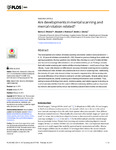Are developments in mental scanning and mental rotation related?
| dc.contributor.author | Wimmer, Marina | |
| dc.contributor.author | Robinson, EJ | |
| dc.contributor.author | Doherty, MJ | |
| dc.date.accessioned | 2017-03-02T11:05:41Z | |
| dc.date.available | 2017-03-02T11:05:41Z | |
| dc.date.issued | 2017-02-16 | |
| dc.identifier.issn | 1932-6203 | |
| dc.identifier.issn | 1932-6203 | |
| dc.identifier.other | ARTN e0171762 | |
| dc.identifier.uri | http://hdl.handle.net/10026.1/8581 | |
| dc.description.abstract |
The development and relation of mental scanning and mental rotation were examined in 4-, 6-, 8-, 10-year old children and adults (N = 102). Based on previous findings from adults and ageing populations, the key question was whether they develop as a set of related abilities and become increasingly differentiated or are unrelated abilities per se. Findings revealed that both mental scanning and rotation abilities develop between 4- and 6 years of age. Specifically, 4-year-olds showed no difference in accuracy of mental scanning and no scanning trials whereas all older children and adults made more errors in scanning trials. Additionally, the minority of 4-year-olds showed a linear increase in response time with increasing rotation angle difference of two stimuli in contrast to all older participants. Despite similar developmental trajectories, mental scanning and rotation performances were unrelated. Thus, adding to research findings from adults, mental scanning and rotation appear to develop as a set of unrelated abilities from the outset. Different underlying abilities such as visual working memory and spatial coding versus representing past and future events are discussed. | |
| dc.format.extent | e0171762-e0171762 | |
| dc.format.medium | Electronic-eCollection | |
| dc.language | en | |
| dc.language.iso | en | |
| dc.publisher | Public Library of Science (PLoS) | |
| dc.subject | Adult | |
| dc.subject | Child | |
| dc.subject | Cognition | |
| dc.subject | Female | |
| dc.subject | Human Development | |
| dc.subject | Humans | |
| dc.subject | Intelligence Tests | |
| dc.subject | Male | |
| dc.title | Are developments in mental scanning and mental rotation related? | |
| dc.type | journal-article | |
| dc.type | Journal Article | |
| plymouth.author-url | https://www.ncbi.nlm.nih.gov/pubmed/28207810 | |
| plymouth.issue | 2 | |
| plymouth.volume | 12 | |
| plymouth.publication-status | Published online | |
| plymouth.journal | PLoS One | |
| dc.identifier.doi | 10.1371/journal.pone.0171762 | |
| plymouth.organisational-group | /Plymouth | |
| plymouth.organisational-group | /Plymouth/Faculty of Health | |
| plymouth.organisational-group | /Plymouth/REF 2021 Researchers by UoA | |
| plymouth.organisational-group | /Plymouth/REF 2021 Researchers by UoA/UoA04 Psychology, Psychiatry and Neuroscience | |
| plymouth.organisational-group | /Plymouth/Research Groups | |
| plymouth.organisational-group | /Plymouth/Research Groups/Centre for Brain, Cognition and Behaviour (CBCB) | |
| plymouth.organisational-group | /Plymouth/Research Groups/Centre for Brain, Cognition and Behaviour (CBCB)/Cognition | |
| dc.publisher.place | United States | |
| dcterms.dateAccepted | 2017-01-25 | |
| dc.identifier.eissn | 1932-6203 | |
| dc.rights.embargoperiod | Not known | |
| rioxxterms.versionofrecord | 10.1371/journal.pone.0171762 | |
| rioxxterms.licenseref.uri | http://www.rioxx.net/licenses/all-rights-reserved | |
| rioxxterms.licenseref.startdate | 2017-02-16 | |
| rioxxterms.type | Journal Article/Review | |
| plymouth.oa-location | http://journals.plos.org/plosone/article?id=10.1371/journal.pone.0171762 |


